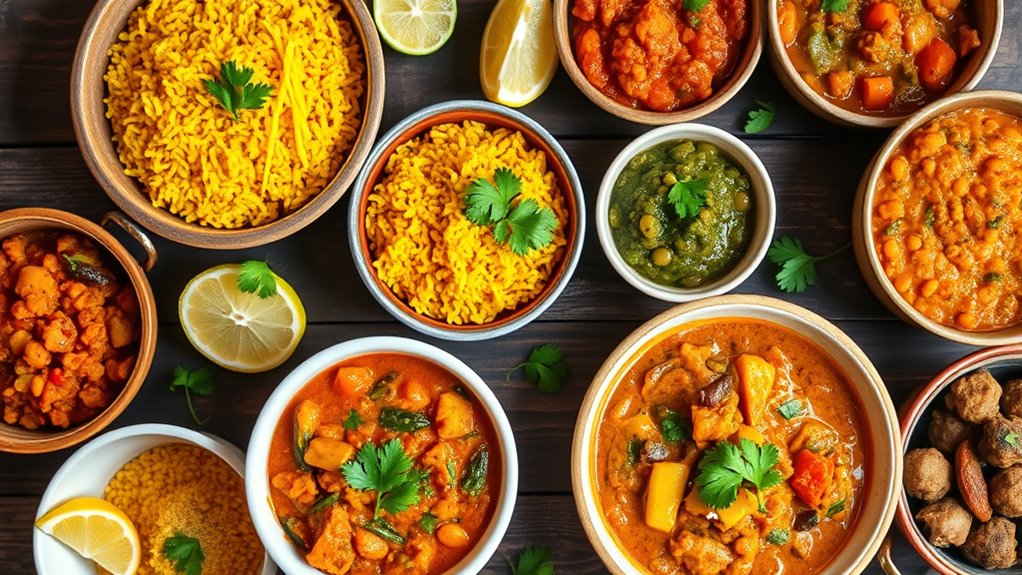To prep easy Indian vegetarian meals for the week, plan a balanced menu with flavorful rice, hearty curries, and tasty lentils. Stock your pantry with staples like basmati rice, chickpeas, lentils, and essential spices such as cumin, turmeric, and garam masala. Cook large batches of rice and curries, then store in airtight containers for quick reheating. Focus on prepping condiments like chutneys in advance. If you continue exploring, you’ll discover simple tips to streamline your meal prep even further.
Key Takeaways
- Plan a diverse weekly menu with balanced grains, legumes, vegetables, and occasional desserts for variety.
- Stock essential ingredients like rice, lentils, spices, and fresh produce for quick meal assembly.
- Prepare and store staples such as cooked lentils, chutneys, and flavored rice in advance for convenience.
- Cook vegetable curries and rice in bulk, focusing on proper spice blending and ingredient pairing.
- Use airtight containers to store, reheat, and layer dishes for easy on-the-go meals and efficient leftovers.
Planning Your Weekly Indian Vegetarian Menu
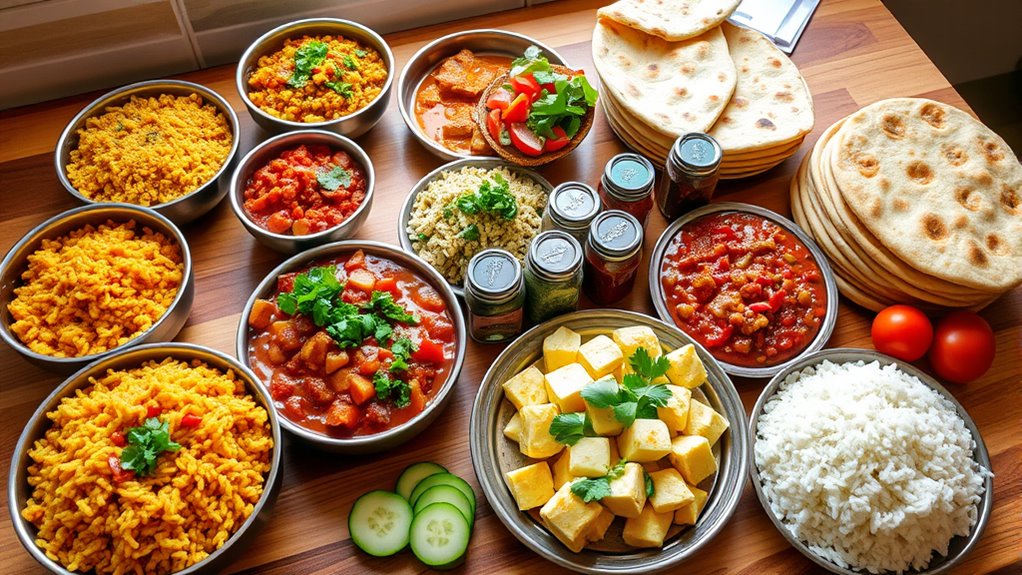
Are you wondering how to create a balanced and flavorful weekly Indian vegetarian menu? Start by planning dishes that incorporate a variety of flavors and textures. Think about including Indian dessert ideas like kheer or gulab jamun to add sweetness and variety. Use traditional cooking utensils, such as a heavy-bottomed wok or a pressure cooker, to prepare these dishes efficiently. Map out your week to ensure you have enough protein, vegetables, and grains each day. Focus on balancing spicy, savory, and sweet elements to keep meals exciting. Planning ahead helps you shop smarter and saves time during busy weekdays. Additionally, considering the use of specialized cookware can enhance cooking efficiency and meal quality. With a clear plan, you’ll enjoy delicious, authentic Indian meals that satisfy every craving while keeping prep manageable.
Essential Ingredients for Indian Meal Prep
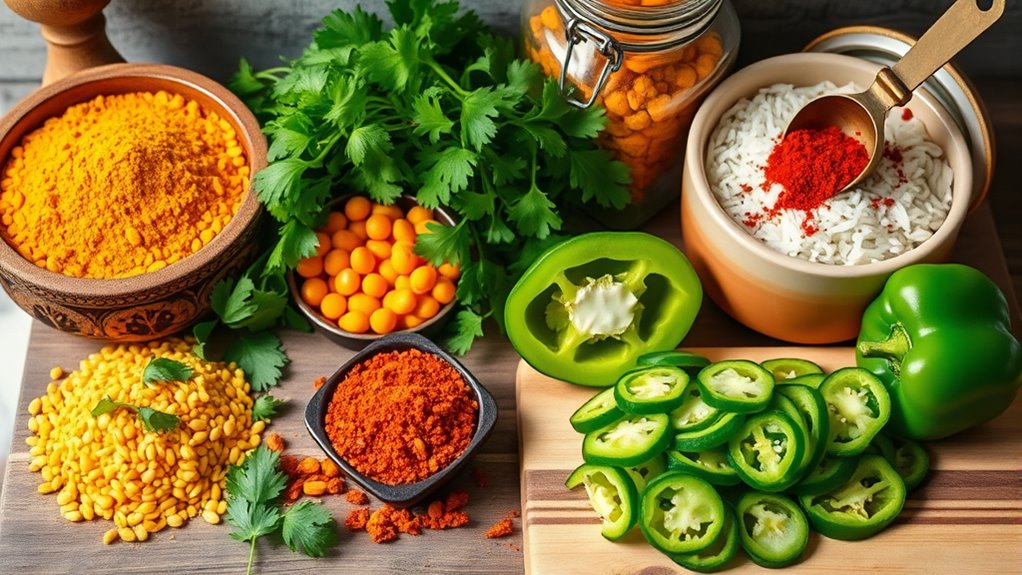
To prepare authentic Indian vegetarian meals, you’ll need staple grains and legumes like rice, lentils, and chickpeas. Essential spices and herbs such as cumin, turmeric, and coriander add flavor and depth, while fresh vegetables and fruits bring vibrancy and nutrition. Having these ingredients on hand makes meal prep efficient and flavorful. Additionally, incorporating traditional candy ingredients can inspire creative dessert options to complement your meals.
Staple Grains and Legumes
Staple grains and legumes form the backbone of Indian vegetarian meals, providing both nourishment and flavor. You’ll want to stock a variety of grain varieties like rice, basmati, and whole wheat, which serve as the foundation for many dishes. For pulse selection, choose options such as lentils, chickpeas, and kidney beans, which cook quickly and add protein to your meals. Keep these staples on hand to create diverse dishes like pulao, dals, and chana masala. Using different grain varieties and pulses ensures variety and nutrition throughout the week. By having a well-stocked pantry of these essential ingredients, you’ll make meal prep easier, faster, and more flavorful, helping you enjoy authentic Indian vegetarian dishes every day.
Essential Spices & Herbs
What makes Indian vegetarian dishes so flavorful and aromatic are the essential spices and herbs you include in your pantry. Mastering spice blending is key to creating authentic tastes, so keep a variety of cumin, coriander, turmeric, garam masala, and mustard seeds readily available. These spices form the backbone of many dishes, providing depth and warmth. Herbs like cilantro, mint, and curry leaves add fresh, vibrant notes. Beyond flavor, many spices and herbs have herbal remedies’ benefits, supporting digestion and immunity. Having these ingredients on hand allows you to quickly season your meals without extra effort. With a well-stocked spice cabinet, you can effortlessly craft flavorful, healthy dishes that capture the essence of Indian cuisine every week. Understanding the importance of flavor in Indian cooking can help you appreciate how these ingredients contribute to both taste and health benefits.
Fresh Vegetables & Fruits
Fresh vegetables and fruits elevate the flavor and nutrition of your Indian vegetarian meals, bringing brightness and texture to every dish. Using seasonal produce guarantees you get the freshest, most flavorful options, while variety keeps your meals interesting. Include a mix of leafy greens, root vegetables, and colorful peppers to add depth to curries and stir-fries. For fruits, choose versatile varieties like mango, pomegranate, or citrus, which can be enjoyed fresh or added to salads and chutneys. Shopping for in-season produce also helps you save money and supports local farmers. Keep a well-stocked selection of fresh vegetables and fruits in your fridge and pantry, so you’re always ready to prepare vibrant, healthy Indian meals throughout the week. Incorporating fresh produce into your meal prep not only enhances taste but also ensures you receive a wide range of essential nutrients.
Preparing and Storing Lentils and Pulses
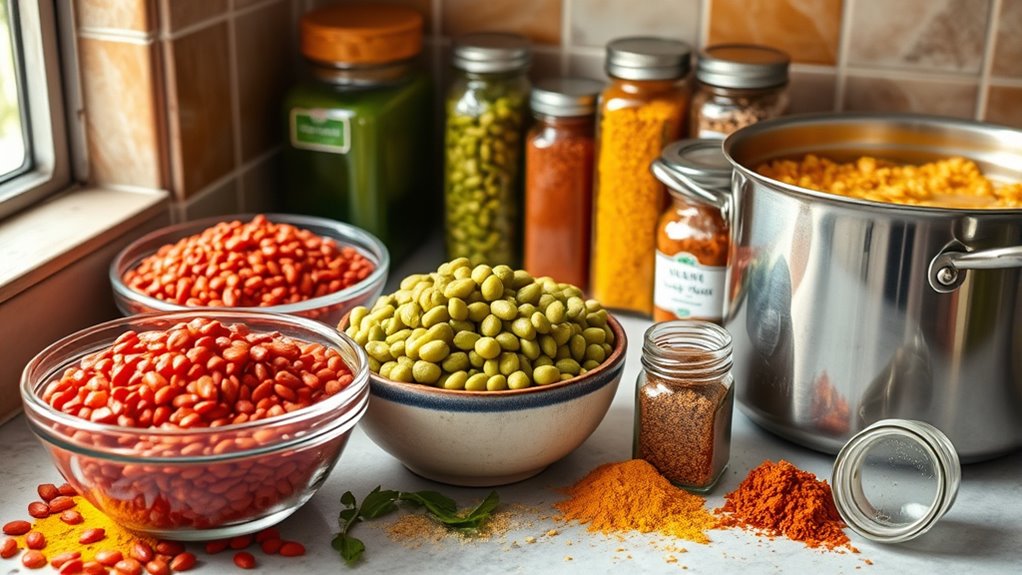
Before cooking lentils and pulses, it’s important to rinse them thoroughly under cold water to remove dirt, debris, or impurities. Different lentil varieties, such as red, green, or brown, may require slightly different cooking times, but rinsing is essential for all. After rinsing, you can soak pulses for faster cooking and better digestibility, especially chickpeas or kidney beans. To store pulses, keep them in airtight containers in a cool, dry place away from sunlight. Proper pulse storage extends their shelf life and prevents pests. If you buy in bulk, divide pulses into portions for easy use. Always check for any signs of spoilage before cooking. Rinsing and proper storage ensure your lentils and pulses remain fresh, nutritious, and ready for your meal prep. Additionally, using high-efficiency solar panels can help power your kitchen appliances sustainably while meal prepping.
Making a Batch of Flavored Rice and Basmati Variations
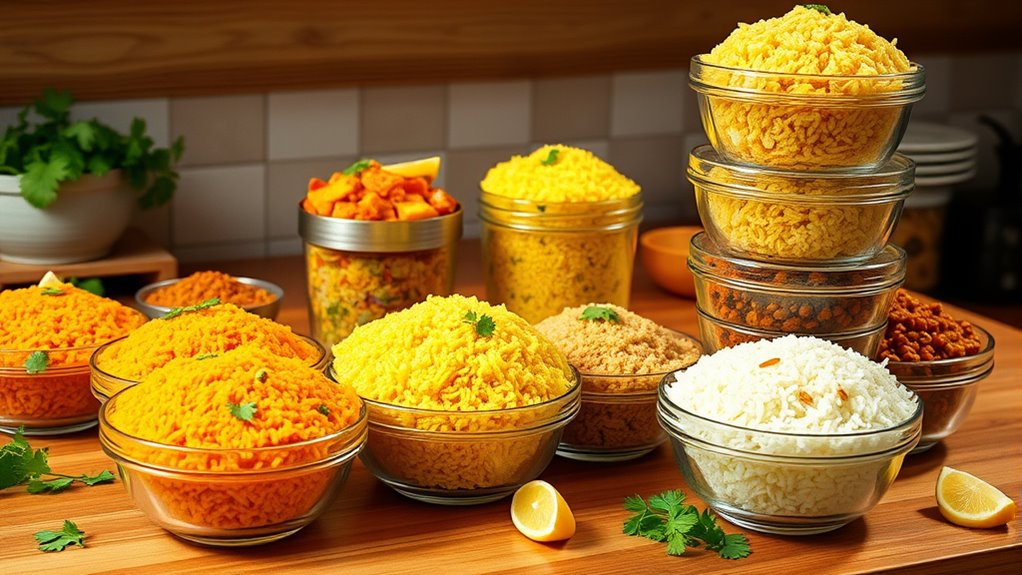
You can quickly prepare a batch of flavored rice and basmati variations to add depth to your meals. Experiment with different spices, herbs, and ingredients to create unique tastes. Paying attention to basmati rice tips guarantees your rice stays fluffy and fragrant every time. Incorporating the right lighting can also enhance the presentation and aroma of your dishes.
Subheading 1: Flavored Rice Variations
Making a batch of flavored rice is a simple way to add variety to your meals and save time during busy days. To do this, focus on spice blending and rice seasoning techniques that enhance the natural flavor of the grains. Start by cooking your rice, then toss in your preferred spice blends—think cumin, coriander, turmeric, or garam masala—to create vibrant, aromatic variations. You can also add herbs like cilantro or mint for fresh notes. For Basmati rice, rinsing it beforehand helps achieve that fluffy texture. Mix in your seasonings after cooking or sauté the spices briefly before adding the rice. These flavored rice variations not only diversify your meals but also keep them exciting, all while being quick to prepare ahead of time.
Subheading 2: Basmati Rice Tips
Ever wonder how to get perfectly fluffy and flavorful Basmati rice every time? The key is in proper spice blending and rice storage. Start by rinsing the rice thoroughly to remove excess starch, then soak it for 20-30 minutes for ideal fluffiness. When cooking, add a pinch of salt and a little oil or ghee for added aroma. To enhance flavor, create a spice blend with cardamom, cinnamon, or cloves, and stir it into the cooking water. Once cooked, let the rice sit covered for a few minutes before fluffing with a fork. Store any leftover rice in an airtight container in the fridge, and reheat it with a splash of water. Proper storage keeps your rice fresh, flavorful, and ready for your next meal. Incorporating a consistent cooking technique ensures uniform results every time.
Cooking and Preserving Popular Vegetable Curries
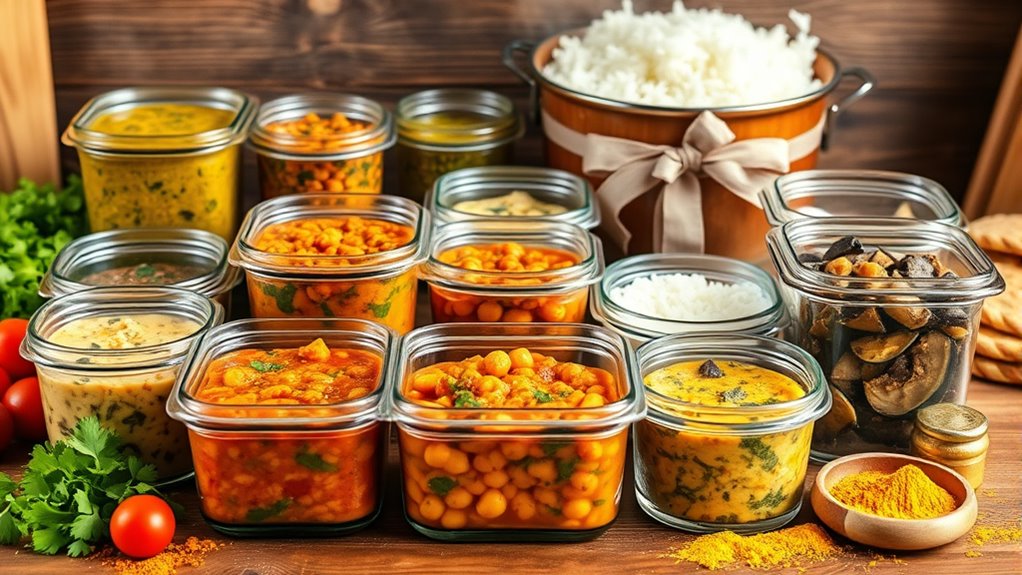
Cooking and preserving popular vegetable curries is essential for meal prep, as it allows you to enjoy flavorful dishes throughout the week. Focus on proper spice blending to build depth and aroma in your curries. Use fresh, vibrant vegetables like spinach, cauliflower, or carrots for the best results, ensuring they hold up well during storage. When cooking, sauté spices first to release their flavors, then add vegetables and liquids, simmering until tender. To preserve, let the curries cool completely before portioning into airtight containers. Store in the refrigerator for up to four days or freeze for longer shelf life. Reheat thoroughly before serving, and consider adding fresh herbs or a squeeze of lemon to brighten flavors when serving later.
Creating Easy and Versatile Chutneys and Pickles
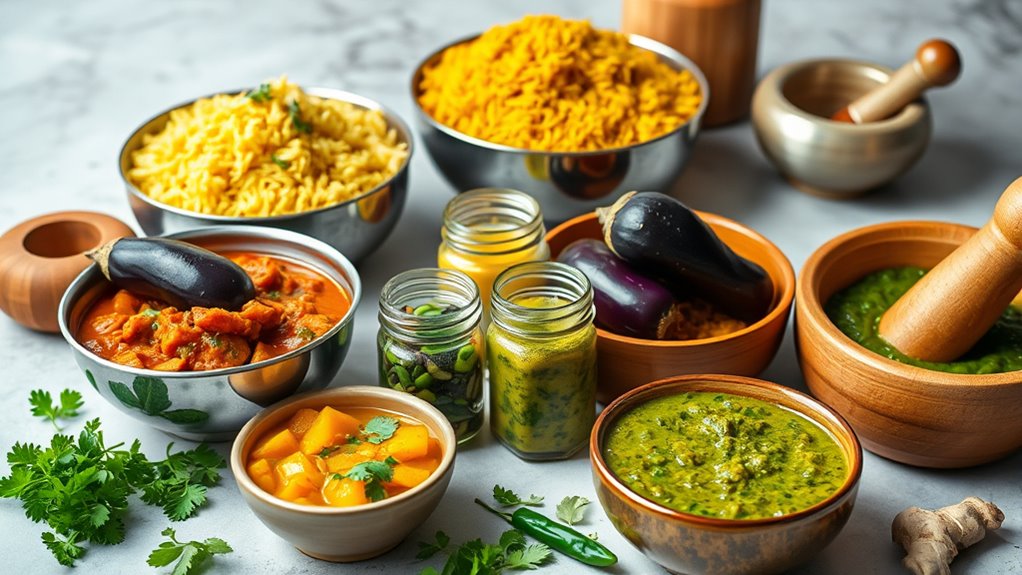
Creating easy and versatile chutneys and pickles is a great way to add flavor and variety to your vegetarian meals. To do this, focus on spice blending, combining ingredients like cumin, coriander, and chili for balanced heat and aroma. Experiment with different chutney varieties such as mint, coconut, or tomato, to complement your dishes. Pickles, like mango or lemon, can be prepared in advance and stored for weeks, enhancing your meals with tangy zest. Use fresh herbs and spices to customize flavors, and keep the consistency adaptable—some chutneys are smooth, others chunky. By mastering simple spice blending techniques, you’ll create a range of condiments that elevate your meal prep, making every dish more flavorful and exciting throughout the week. Incorporating mindful storage strategies can also ensure your condiments stay fresh and ready to enjoy.
Meal Assembly: Combining Components for Quick Dinners
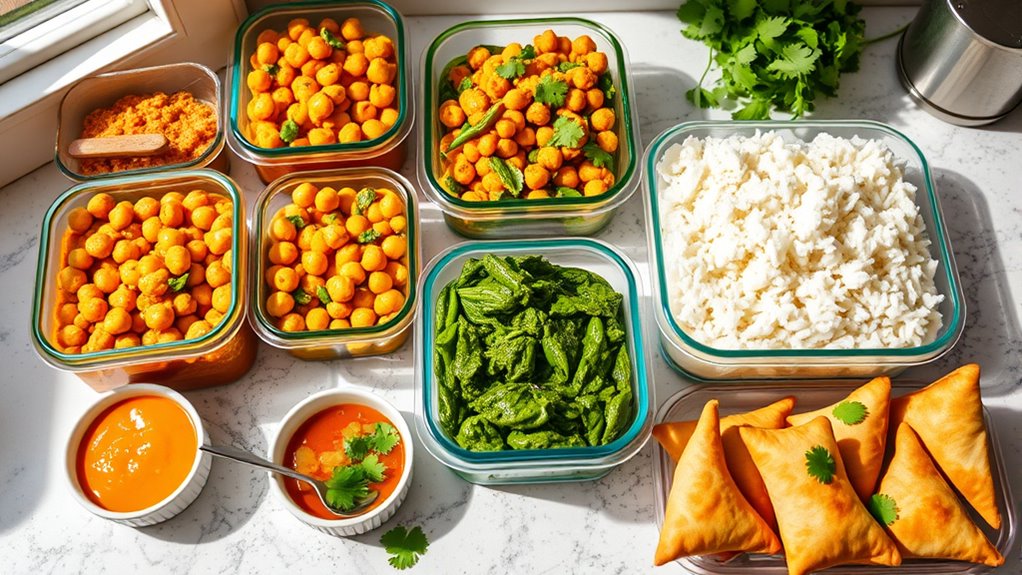
You can quickly assemble a flavorful meal by pairing ingredients thoughtfully, saving time without sacrificing taste. Layering components like rice, vegetables, and chutneys creates a satisfying, balanced plate. Mastering these techniques helps you serve delicious dinners in minutes. Incorporating fresh ingredients ensures the best flavor and nutritional value.
Efficient Ingredient Pairing
Efficient ingredient pairing is essential for quick and satisfying Indian vegetarian meals. When you combine ingredients thoughtfully, you save time and guarantee flavors complement each other. Focus on spice blending to create versatile flavor bases—prepare a mix of common spices like cumin, coriander, and turmeric to use across multiple dishes. This speeds up cooking and maintains consistency. Pay attention to curry consistency; aim for a smooth, thick sauce that coats ingredients evenly. Using pre-cooked lentils, beans, or vegetables allows you to assemble meals rapidly without sacrificing flavor. Additionally, pairing ingredients that cook at similar speeds reduces overall prep and cooking time. Mastering these meal assembly techniques can significantly streamline your cooking process while delivering rich, flavorful Indian vegetarian dishes.
Layered Serving Techniques
Layered serving techniques streamline Indian vegetarian meal assembly by allowing you to combine components quickly and visually appealingly. With layered serving, you create a beautiful presentation that elevates simple dishes. To do this effectively:
- Start with a sturdy base, like rice or flatbread, to anchor the layers.
- Add colorful components, such as vegetable curries or chutneys, for visual appeal.
- Finish with toppings like fresh herbs or crunchy garnishes to enhance texture and flavor.
This approach not only simplifies meal prep but also impresses your family or guests. Using presentation techniques like layering makes your dishes more appetizing and memorable. Whether in bowls or plates, layered serving turns quick meals into elegant, satisfying Indian vegetarian dishes.
Tips for Freezing and Reheating Indian Dishes
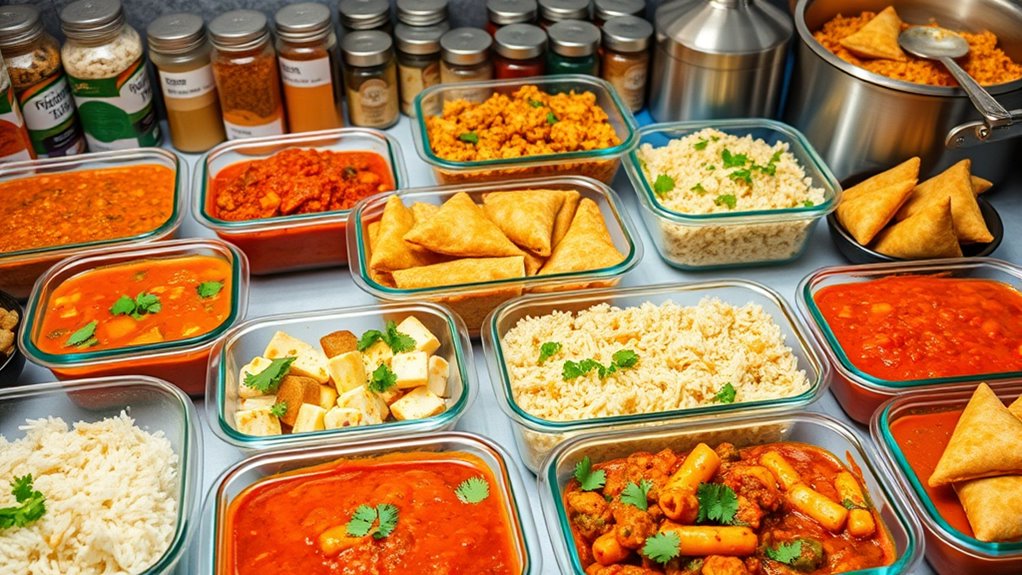
Freezing Indian dishes requires careful planning to preserve their flavor and texture. To keep dishes fresh, cool them completely before storing. Use airtight containers or heavy-duty freezer bags, removing excess air to prevent freezer burn. Label each container with the date and dish name. When reheating, follow proper reheating methods to restore taste and consistency. Use a microwave for quick reheats, or gently reheat on the stovetop with a splash of water or broth to prevent dryness. Avoid freezing dishes with dairy or potatoes for long periods, as textures can change. Here’s a quick guide:
| Dish Type | Freezing Tips | Reheating Methods |
|---|---|---|
| Curries | Cool completely, freeze in portions | Microwave or stovetop, stir often |
| Lentils | Use airtight containers | Simmer on low heat, add water |
| Rice | Spread thin to cool, freeze in portions | Microwave with a damp cloth |
| Vegetable Sabzis | Freeze in small containers | Reheat gently on stovetop |
| Breads & Parathas | Wrap tightly in foil or plastic | Toast or reheat in oven |
Packing Indian Vegetarian Meals for Work and On-the-Go

Wondering how to keep Indian vegetarian meals fresh and flavorful when packed for work or on the go? Focus on using traditional spice blends and regional cooking techniques to maintain authenticity. Here are three tips:
- Use airtight containers to lock in aroma and prevent spills.
- Pack sauces and curries separately to avoid sogginess, adding them just before eating.
- Layer ingredients smartly—place sturdier items like rice or bread at the bottom and delicate veggies on top.
Incorporate regional techniques like tempering spices or adding fresh herbs just before packing to boost flavor. Using authentic spice blends helps keep dishes vibrant, even after hours in a lunchbox. With these strategies, your Indian vegetarian meals stay delicious and true to their origins.
Maintaining Freshness and Flavor Throughout the Week
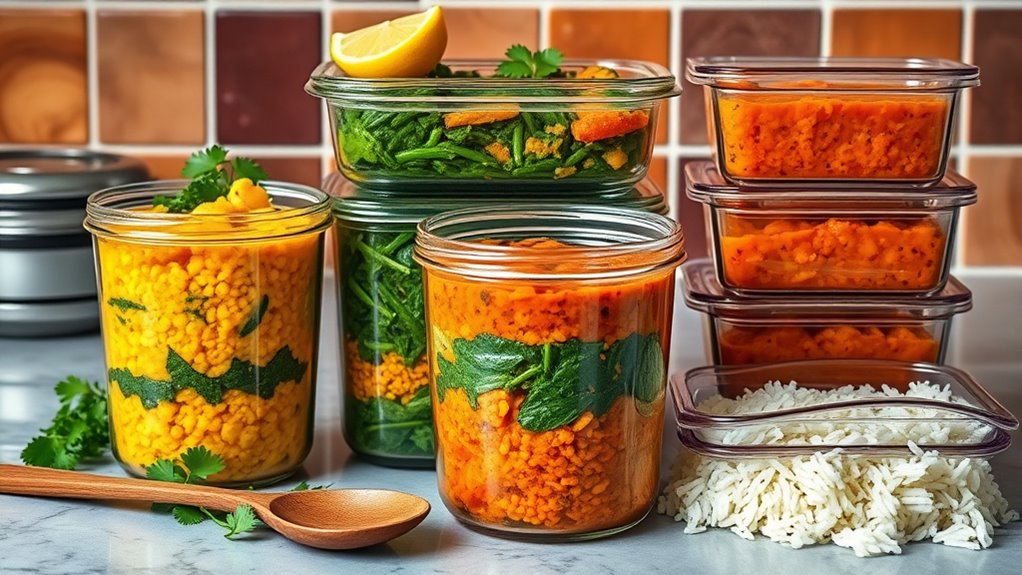
To keep your Indian vegetarian meals fresh and flavorful throughout the week, focus on proper storage techniques and mindful reheating. Store dishes in airtight containers to preserve moisture and prevent odor transfer. Keep traditional spices separate if possible, adding them fresh during reheating to maintain their vibrant aroma and taste. Using small, portioned containers helps prevent overexposure to air, which can diminish flavor. When reheating, do so gently to avoid overcooking, and add fresh herbs just before serving to boost freshness. This simple step ensures your meals retain their bright, authentic flavors. Proper storage and gentle reheating keep the spices fragrant and the herbs lively, ensuring each bite remains delicious and true to its original flavor profile.
Frequently Asked Questions
How Can I Vary Indian Vegetarian Meals to Prevent Boredom?
To keep your Indian vegetarian meals exciting, experiment with different spice combinations to add new flavors each time. Incorporate regional variations, like North Indian dals or South Indian dosas, to diversify your dishes. You can also swap ingredients or try new cooking techniques, keeping your meals fresh and interesting. This variation prevents boredom and helps you discover your favorite regional and flavor profiles within Indian cuisine.
What Are Some Budget-Friendly Ingredients for Indian Meal Prep?
Think of your pantry as a treasure chest for budget-friendly Indian meal prep. You can stretch your dollars by focusing on staple ingredients like affordable lentil varieties—red, green, or yellow—and mastering spice blending to create rich flavors without extra costs. Incorporate inexpensive vegetables like potatoes, carrots, and spinach, which add variety and nutrition. These ingredients keep your meals flavorful, versatile, and budget-conscious, making your weekly prep both economical and delicious.
How Long Do Cooked Indian Dishes Stay Safe in the Fridge?
When it comes to food storage, cooked Indian dishes typically stay safe in the fridge for 3 to 4 days. Make sure to store them in airtight containers to maintain freshness. For reheating safety, always heat your leftovers thoroughly to an internal temperature of 165°F. Avoid leaving cooked food out at room temperature for more than two hours to prevent bacterial growth. Proper storage and reheating guarantee your meals stay safe and delicious.
Are There Vegetarian Indian Dishes Suitable for Beginners?
Starting your Indian culinary journey is like opening a treasure chest—there’s so much to explore! Yes, there are vegetarian Indian dishes perfect for beginners, like chana masala or aloo gobi. You can also try simple vegetarian snack ideas and Indian dessert options to satisfy your sweet tooth. These dishes are straightforward, flavorful, and a great way to build confidence while enjoying authentic tastes.
How Can I Adapt Indian Recipes for Gluten-Free Diets?
You can adapt Indian recipes for gluten-free diets by swapping in gluten-free flours like chickpea or rice flour for wheat-based ingredients. Use alternative grains such as millet, quinoa, or amaranth instead of traditional wheat or barley. These adjustments help you enjoy authentic flavors while maintaining a gluten-free diet. Just make certain all seasonings and processed ingredients are gluten-free, and you’ll create delicious, safe Indian dishes effortlessly.
Conclusion
With a little planning, you can enjoy delicious Indian vegetarian meals all week without hassle. Even if you’re short on time, prepping ingredients in advance makes quick assembly easy. Don’t worry about leftovers; proper storage keeps flavors fresh and vibrant. Stick to this simple routine, and you’ll always have flavorful, nutritious meals ready to go, proving that healthy Indian eating at home can be both effortless and satisfying.
